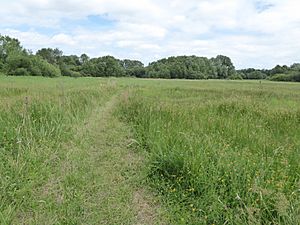Blo' Norton and Thelnetham Fens facts for kids
| Site of Special Scientific Interest | |

Thelnetham Fen
|
|
| Area of Search | Norfolk Suffolk |
|---|---|
| Interest | Biological |
| Area | 21.3 hectares |
| Notification | 1983 |
| Location map | Magic Map |
Blo' Norton and Thelnetham Fens is a special natural area. It's called a Site of Special Scientific Interest (SSSI) because of its amazing wildlife. This area is about 21.3 hectares big. That's like 30 football fields! It sits right on the border between Norfolk and Suffolk in England.
Blo' Norton Fen is in the village of Blo' Norton in Norfolk. Thelnetham Fen is in Thelnetham village in Suffolk. This whole area is a very important place for nature. It's even part of a bigger protected area called the Waveney and Little Ouse Valley Fens Special Area of Conservation. Thelnetham Fen is looked after by the Suffolk Wildlife Trust. Blo' Norton Fen is managed by the Little Ouse Headwaters Project (LOHP).
Contents
Where is this Special Place?
This SSSI is located right on the border of Norfolk and Suffolk. You can find it south of the A1066 road. This road goes between Diss and Thetford. It's also north of the A143 road, which connects Diss and Bury St Edmunds.
To give you an idea of its location:
- It's about 6 miles (10 km) west of Diss.
- It's about 10 miles (16 km) south-east of Thetford.
- It's about 14 miles (23 km) north-east of Bury St Edmunds.
Another important SSSI, Redgrave and Lopham Fens, is only about 2 miles (3 km) east of this site.
Amazing Nature and Wildlife
This special area has different types of habitats. It has wet areas called fen wetlands. These fens have soil rich in lime. There are also wet woodlands, known as carr woodland, and grassy meadows. All these areas are found along the River Little Ouse. This river actually forms the border between the two counties!
Rare Plants Thrive Here
Blo' Norton and Thelnetham Fens are super important worldwide. This is because they are home to some very rare plants. These include the black bog rush (Schoenus nigricans) and saw sedge (Cladium mariscus).
The wetter parts of the fen have many different plant species. You'll mostly see black bog rush, saw sedge, and purple moor grass (Molinia caerulea). But you can also find other special plants. These include fen orchid (Dactylorchis praetermissa), devil’s bit scabious (Succisa pratensis), and quaking grass (Briza media). There are even some rare types of mosses growing here!
Different Plants for Different Areas
Some parts of the fen can get drier when there isn't much rain. These drier spots have different plants. You'll often see taller plants like common reed (Phragmites australis) and meadowsweet (Filipendula ulmaria). Other plants that like these areas include hemp agrimony (Eupatorium cannabinum) and purple loosestrife (Lythrum salicaria). This mix of plants makes the area home to even more different kinds of life.
There are also areas with bushes and trees. These include sallow and alder trees. Blo' Norton Fen even has some oak and ash trees.
Animals of the Fen
The meadows and ditches around the fen also support many species. You might spot plants like ragged robin (Lychnis flos-cuculi) and marsh marigold (Caltha palustris).
Many birds live here too, such as snipe and grasshopper warbler. A protected animal, the Eurasian water shrew, also makes its home in this area.
Looking After the Fen
To keep the fen healthy and full of different plants and animals, people manage it carefully. They regularly cut back some of the plants in the fen. This is done on a four-year cycle. This helps to keep the area diverse and provides different places for wildlife to live.
Years ago, a nearby area called Hinderclay Fen was removed from the SSSI. This happened in 1983 because it became too dry from drainage projects. However, the LOHP has started to manage Hinderclay Fen again. They are working to bring it back to a more natural state. This includes cutting back bushes and creating new ponds.
In the past, people used the fen to cut peat for fuel. They also gathered wood for fires. Today, there are marked paths for visitors to explore. These paths include wooden boardwalks and a footbridge over the Little Ouse River. The Angles Way long-distance path also goes through the SSSI.
How to Visit
You can get to Thelnetham Fen from Loggers Lane. Blo' Norton Fen can be reached from Fen Road. A bridge over the River Little Ouse connects the two fen areas. The Angles Way footpath also runs right through Thelnetham Fen, making it easy to explore.

